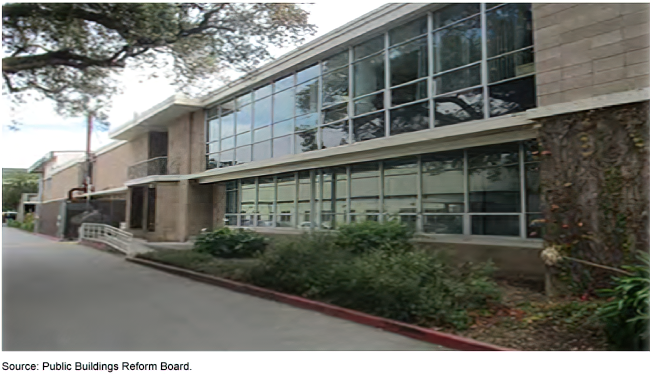Federal Real Property: GSA Should Leverage Lessons Learned from New Sale and Transfer Process
Fast Facts
Managing federal real property—e.g., buildings—is a longstanding challenge that's on our High Risk list.
A 2016 law set up a three-round process to select and prepare unneeded federal properties for sale. Proceeds from prior rounds of sales go into a fund to help pay upfront costs for the next round.
Participating agencies said they faced setbacks. Delays in selling first-round properties reduced the amount of available proceeds—limiting how many properties could be sold in the second round.
We recommended that the General Services Administration collect, share, and apply lessons learned to the final round and future property reduction efforts.
An example of a property in Menlo Park, California, listed for sale in 2022

Highlights
What GAO Found
The Federal Assets Sale and Transfer Act of 2016 (FASTA) established a new, temporary three-round process for reducing the federal government's inventory of federal civilian real property. Stakeholders in this process include the temporary Public Buildings Reform Board (Board), the General Services Administration (GSA), the Office of Management and Budget (OMB), and selected federal agencies. They told GAO they had encountered numerous setbacks while implementing the first two rounds and identified potential options to address setbacks in the final 2024 round. For example:
- Delays selling properties. Although $194 million in sales of 10 unneeded properties have occurred so far, it took almost 2 years to sell any of the properties OMB approved for disposal during the first round in 2019. According to stakeholders, this setback was due, in part, to an evolving sales strategy.
- Limited Board recommendations. Sales proceeds generated from prior rounds are intended to fund costs associated with implementing OMB-approved Board recommendations in subsequent rounds, pending congressional appropriation. According to Board officials, the lack of sales proceeds deposited and appropriated from the first round limited the number, value, and complexity of properties it could recommend for the second round in 2021.
Stakeholders told GAO that committing to a sales strategy early in the process and examining the deadlines under FASTA could help mitigate some of the setbacks encountered in prior rounds.
GSA—which has the responsibility to work with federal agencies to help execute the Board's recommendations—has not developed a process that fully leverages lessons learned from this process. Although GSA has developed internal lessons learned, it has not collected or applied lessons learned from other stakeholders, including the Board and OMB. Nor has GSA formally shared any of its internal lessons learned with stakeholders, including Congress. In addition, as the federal government's disposal agent, GSA has not fully assessed the applicability of lessons learned to future disposal efforts, including possible changes to the traditional disposal process. As agencies' space needs evolve due to the COVID-19 pandemic, disposals of unneeded properties may become more important. GAO has found that the use of a lessons learned process, particularly lessons from pilot programs such as this temporary process, could help inform decision-making and process improvement. Collecting and sharing lessons from interagency efforts is especially valuable because agencies can learn from each other. Without a process to collect, share, and apply lessons learned from all key stakeholders, including Congress, any insights this experience could provide on how the federal government could better dispose of its properties may be limited or lost.
Why GAO Did This Study
Federal agencies face long-standing challenges in disposing of unneeded real property. These challenges include lengthy disposal processes related to statutory and regulatory requirements and a lack of upfront funding. Management of federal real property is on GAO's high-risk list. FASTA included provisions for GAO to review the Board's real property identification and selection process and agencies' efforts to implement the Board's recommendations. GAO's January 2021 report addressed the Board's process.
This report examines: options to mitigate setbacks that stakeholders identified while implementing FASTA, and the extent to which GSA has collected and applied lessons learned to the final 2024 round, among other objectives. GAO reviewed FASTA and analyzed documents from the Board, OMB, GSA, and six selected federal agencies. GAO selected agencies based on their inclusion on the Board's list of recommended property candidates for the 2019 and 2021 rounds, among other factors. GAO interviewed officials from the Board, GSA, and selected federal agencies, and staff from OMB.
Recommendations
GAO is recommending that GSA, in consultation with relevant stakeholders, develop a process to collect, share, and apply lessons learned from the implementation of FASTA, including reporting any lessons learned to Congress. GSA agreed with the recommendation and stated that it is developing a plan to address it.
Recommendations for Executive Action
| Agency Affected Sort descending | Recommendation | Status |
|---|---|---|
| General Services Administration |
Priority Rec.
The Administrator of the GSA, in consultation with relevant stakeholders, should develop a process to collect, share, and apply lessons learned from the implementation of FASTA to improve the final 2024 round and future disposal efforts, including reporting any lessons learned through this process, to Congress. (Recommendation 1) |
Open – Partially Addressed
In February 2024, GSA officials provided additional information on ongoing collaboration with stakeholders and how FASTA lessons learned were being used to identify strategies for disposing of unneeded government properties, which could result in cost savings. To fully implement this recommendation, GSA needs to develop a documented process to work with relevant stakeholders to identify and implement solutions to address numerous setbacks encountered throughout the FASTA process. This action could leverage stakeholders' knowledge and experiences with FASTA to make and agree upon necessary changes for the final FASTA round, and identify useful and financially beneficial concepts to include as part of future efforts to reduce the federal government's real property inventory. GAO will continue to monitor GSA's progress to address this recommendation.
|
